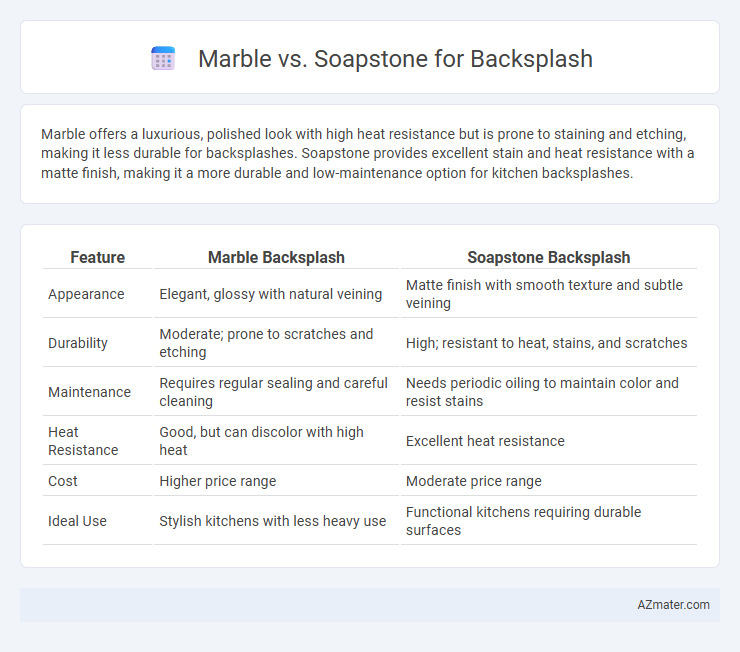Marble offers a luxurious, polished look with high heat resistance but is prone to staining and etching, making it less durable for backsplashes. Soapstone provides excellent stain and heat resistance with a matte finish, making it a more durable and low-maintenance option for kitchen backsplashes.
Table of Comparison
| Feature | Marble Backsplash | Soapstone Backsplash |
|---|---|---|
| Appearance | Elegant, glossy with natural veining | Matte finish with smooth texture and subtle veining |
| Durability | Moderate; prone to scratches and etching | High; resistant to heat, stains, and scratches |
| Maintenance | Requires regular sealing and careful cleaning | Needs periodic oiling to maintain color and resist stains |
| Heat Resistance | Good, but can discolor with high heat | Excellent heat resistance |
| Cost | Higher price range | Moderate price range |
| Ideal Use | Stylish kitchens with less heavy use | Functional kitchens requiring durable surfaces |
Introduction to Marble and Soapstone Backsplashes
Marble backsplashes, renowned for their elegant veining and polished finish, add timeless luxury and brightness to kitchen designs, especially using varieties like Carrara or Calacatta. Soapstone backsplashes offer a matte, smooth texture with excellent heat resistance and minimal maintenance, typically found in soft gray or deep charcoal shades that develop a unique patina over time. Both materials provide durable and stylish options, but marble demands more careful sealing to prevent staining, while soapstone ages gracefully with increased use.
Aesthetic Appeal: Marble vs Soapstone
Marble offers a luxurious, timeless aesthetic with its natural veining and high-gloss finish, making it a popular choice for elegant backsplashes. Soapstone provides a more muted, matte appearance with subtle veining and a soft, tactile feel, ideal for rustic or modern farmhouse kitchens. The choice between marble and soapstone hinges on whether a homeowner prefers a bright, polished surface or a more understated, durable look.
Durability and Longevity Comparison
Soapstone offers superior durability and resistance to heat, stains, and scratches, making it ideal for high-traffic kitchen backsplashes. Marble, while visually stunning with its unique veining, is more porous and prone to etching and staining, requiring regular sealing to maintain its appearance. Over time, soapstone's resilience ensures longer-lasting performance and less maintenance compared to marble in backsplash applications.
Maintenance and Cleaning Requirements
Marble backsplashes demand frequent sealing and gentle cleaning with pH-neutral products to prevent staining and etching from acidic substances. Soapstone requires minimal maintenance due to its non-porous nature, allowing easy cleaning with water and mild soap while naturally resisting stains and bacteria. Regular application of mineral oil on soapstone enhances its appearance and longevity, whereas marble's polished surface needs more cautious upkeep to avoid dulling.
Heat and Stain Resistance
Soapstone offers superior heat resistance compared to marble, making it ideal for backsplashes near stovetops and ovens where high temperatures are common. Marble, while elegant, is more porous and prone to staining from oils, acidic substances, and spills without regular sealing. Soapstone's dense composition ensures better stain resistance and requires less maintenance, providing a durable and practical option for kitchen backsplashes exposed to heat and frequent use.
Cost and Installation Differences
Marble backsplashes generally cost between $50 and $150 per square foot, while soapstone ranges from $70 to $120 per square foot, making marble often more expensive depending on the grade and source. Installation of marble requires skilled craftsmanship due to its brittleness and susceptibility to chipping, increasing labor costs and complexity compared to soapstone, which is denser and more uniform, allowing for easier cutting and fitting. Soapstone's non-porous nature reduces the need for sealing, potentially lowering long-term maintenance expenses compared to marble, which requires regular sealing to prevent staining and damage.
Suitability for Various Kitchen Styles
Marble backsplashes offer a classic, luxurious appeal ideal for traditional, Mediterranean, and contemporary kitchens due to their elegant veining and polished finish. Soapstone provides a more rustic, matte appearance that suits farmhouse, industrial, and modern minimalist kitchen styles, thanks to its durability and resistance to stains and heat. Choosing between marble and soapstone depends on your kitchen's design theme, desired maintenance level, and the importance of natural texture versus smooth refinement.
Pros and Cons of Marble Backsplashes
Marble backsplashes offer a luxurious, timeless aesthetic with unique veining patterns that enhance kitchen design but require regular sealing to prevent staining and etching from acidic substances. Marble is heat resistant and can tolerate minor scratches, but it is softer and more porous than soapstone, making it prone to chipping and discoloration without proper maintenance. While marble provides a high-end look, its higher cost and sensitivity to harsh cleaners may pose challenges compared to more durable alternatives like soapstone.
Pros and Cons of Soapstone Backsplashes
Soapstone backsplashes offer exceptional durability and resistance to heat, stains, and bacteria, making them ideal for kitchen environments. Their natural resistance to etching and scratching surpasses that of marble, though soapstone may darken and develop a patina over time, which some homeowners find appealing while others consider a drawback. However, soapstone typically requires periodic oiling to maintain its appearance and can be more expensive than other backsplash materials.
Which Backsplash Material is Right for You?
Marble offers a luxurious, classic look with unique veining patterns and superior heat resistance, making it ideal for elegant kitchens but requires regular sealing to prevent staining. Soapstone is highly durable, non-porous, and resistant to heat and stains, providing a matte finish that ages gracefully and demands minimal maintenance. Choosing between marble and soapstone depends on your preference for aesthetic appeal versus practicality and your willingness to maintain the surface.

Infographic: Marble vs Soapstone for Backsplash
 azmater.com
azmater.com